Money tree - growing and caring for home
The money tree is a plant that is covered in magical tales of wealth and success. Thick leaves that resemble coins are the main parameter why it is called that. Otherwise, this plant is called “Crassula” or “Crassula”. The thick trunk and densely dotted leaves resemble not a plant but a small tree. Feng Shui tells us that the better this plant grows, the more leaves, the thicker the trunk and, in general, the better it feels, the more money and success you will have in your home.
Crassula is not sensitive to air humidity. even dry air cannot harm it.
The Crassula is native to the tropical and arid southern and southwestern parts of Africa, as well as Madagascar.
Origin of the name of the plant
The leaves of the plant are collected in a basal rosette, they are sessile, petiolate, and have a round shape resembling a coin. The leaf blades are covered with thick skin, and inside there is pulp. It is precisely because of the external structure of the leaf and the associations that arise in the human imagination that the plant has received several names among the people - fat plant, money tree, fat plant, tree of happiness, tree of good luck.
Folk signs
It is believed that a fat plant growing in a house can attract prosperity and financial wealth. It’s not for nothing that the plant received such a name. It is for this reason that many gardeners grow a money tree, the care of which turns out to be quite simple.
 There is an opinion that a rotting, diseased tree of good luck has the opposite effect. That is, its owner may face failure in business and loss of money. To prevent this from happening, the fat woman growing in the house should always be well-groomed and healthy.
There is an opinion that a rotting, diseased tree of good luck has the opposite effect. That is, its owner may face failure in business and loss of money. To prevent this from happening, the fat woman growing in the house should always be well-groomed and healthy.
- Sometimes it happens that a money tree, which seems to have been cared for according to all the rules, still withers and even dies.
- It turns out that it is very sensitive to the psychological atmosphere that reigns in the house.
- If residents constantly experience stress and discomfort, then the same condition is transmitted to the green pet.
- Over time, the flower can not only get sick, but also die for no apparent reason.
Watering the plant
How to care for a money tree? This question is most often asked by people who decide to start growing plants. There are several main tips regarding watering, replanting, feeding, and propagating the fat plant.
The flower reacts very sensitively to the presence of moisture in the soil. Therefore, you need to know the rules for watering the plant and strictly adhere to the recommendations.
 The money tree flower needs little moisture. In winter, it should be watered no more than once a month or completely eliminated, and in summer it should be done once every 2-3 weeks. In addition, the plant does not like spraying. The procedure can lead to a deterioration in the appearance of the leaves or cause them to rot. Spraying is recommended to be used only in cases where it is necessary to remove dust and other contaminants. After watering, moisture should never remain in the tray of the pot. The water must be drained. If the soil in the pot does not dry out and remains wet for a long time, this means that the substrate or container is not selected correctly. Perhaps the soil is too compacted or the flowerpot is too large.
The money tree flower needs little moisture. In winter, it should be watered no more than once a month or completely eliminated, and in summer it should be done once every 2-3 weeks. In addition, the plant does not like spraying. The procedure can lead to a deterioration in the appearance of the leaves or cause them to rot. Spraying is recommended to be used only in cases where it is necessary to remove dust and other contaminants. After watering, moisture should never remain in the tray of the pot. The water must be drained. If the soil in the pot does not dry out and remains wet for a long time, this means that the substrate or container is not selected correctly. Perhaps the soil is too compacted or the flowerpot is too large.
Lighting conditions
- Too much or too little sunlight is a condition to which all houseplants respond immediately.
- The money tree will actively grow and develop if it is placed in a room with windows facing south.
- But at the same time, it is necessary to protect the fat woman from direct sunlight.
- Otherwise, the leaves may get burned, which will lead to their death.
- To prevent this from happening, you can use partial shading of the window, thus accustoming the tree of luck to bright light.
This advice applies more to plants that have green leaves. It is in fatworts of this type that when direct sunlight hits the leaf blades, the latter acquire a dark brown tint or reddish edges appear on them along the edge. 
An exception may be the variegated Crassula. This is a species that requires plenty of sunlight. It is also believed that for the money tree to bloom, a large amount of light is also needed, including direct sunlight.
- There are known types of Crassula that feel good on western or eastern windows.
- It is possible to place the plants not on the windowsill, but near the window openings.
- A north window will not suit the tree of luck at all.
- After some time, the fat plant will lose its attractiveness - the stems will stretch out, the leaves will become thin. It is even possible for them to fall off.
Temperature
It is well known that temperature changes are very painful for many indoor plants. The money tree is one of those plants that benefit from changes in temperature during the day.
- In winter, the fat woman feels good even at 7-10 degrees Celsius.
- But the optimal temperature for its growth and development is 16-18 degrees.
- At higher winter temperatures, the plant withers, sheds its leaves, and loses its decorative effect.
In the summer, it is best to move the fat plant from the windowsill to the floor, where it is cooler. In summer, the money tree can be placed on the balcony, in the gazebo, or in the open-air garden.

Transplanting a money tree
Every gardener needs to know how to replant indoor plants. The money tree is no exception, and it has its own replanting rules.
As a rule, a tree is replanted for the first time after purchasing it in a store.
- From the shipping container, the fat plant must be placed “at its permanent place of residence” - in a suitable flowerpot.
- But this should be done no earlier than 2-3 weeks after its appearance in the house.
- This is due to the fact that the money tree must adapt to new conditions, so you need to provide the green pet with a gentle regime, eliminating any negative impact on it.
A wide, shallow pot is the best container suitable for planting Crassula. In such a “dwelling”, the roots of the tree will develop well, delivering the necessary nutrients to the leaves and stems.
A young plant requires changing the pot after a year. The old money tree is replanted after two years. At the same time, the leaves and roots of the fat plant require special care. Its leaves are very fragile and break off easily. The root system is quite weak, its location is superficial. After replanting, very careful watering is required, as there is a possibility that the fragile roots may be damaged, which will lead to their rotting. 
Soil selection
- There are no special requirements for the soil intended for planting crassula.
- Any types can be used.
- But ensuring drainage is a mandatory condition that the plant requires.
- The money tree, as mentioned above, is sensitive to excess moisture, so a drainage layer in the pot is simply necessary.
- It may consist of expanded clay, cork or other non-rotting material.
Plant nutrition
Some gardeners, when caring for money trees, ignore the procedure for feeding them. Experts do not advise forgetting about this.
- Crassula (money tree) requires feeding only during the period of active growth of stems and leaves.
- This occurs from late spring to mid-summer.
- The product is applied to the soil no more than once a month.
- For feeding, use universal or special fertilizers.
- Those intended for fertilizing cacti are well suited.

Plant propagation
The money tree flower is very easy to propagate yourself. Planting material can be obtained by separating part of the stem with leaves from an adult flower. After that, the shoot needs to be wilted a little, then placed in the soil and covered with a glass or plastic container on top. After a few days, the new plant takes root and begins to develop.
- You can root a leaf in the same way.
- It produces aerial roots, so propagation by leaf is an even easier method than by cuttings.
There are known cases of propagation of Crassula by seeds, but this option is used quite rarely by amateur gardeners.
Susceptibility to diseases, their signs
The question of how to care for a money tree should be of interest to every amateur gardener. Since the health of the plant depends on compliance with these rules. Although the fat plant is very resistant to diseases, they are still possible.
The signs by which you can determine the presence of a disease in a flower are as follows:
- rotten leaf plates;
- darkened trunk;
- “baldness” of stems;
- brown or white spots on the surface of leaves and shoots.
Causes of plant diseases and measures to eliminate them
Excessive watering can lead to the appearance of rotten leaves on the fat plant. The money tree falls for the same reason. Darkening of the trunk also occurs from excess moisture. To eliminate the disease, it is necessary to stop watering. Within a few weeks, the fat woman can recover. If this does not happen, then the plant will need to be replaced. You can restore it from a cutting, obtaining a new money tree.
- Cases of pets being infected by fungi are also known.
- Brown and whitish spots appear on the leaves and stems of the Crassula.
- In this case, the home money tree must be treated with a special solution produced by industry.
- To protect the fat plant from diseases and preserve its decorative appearance, it is necessary to carefully monitor the development of the plant and immediately respond to all undesirable changes.
Money Tree. Bloom
The structure of the flower of the plant and the color of the petals depends on the type of Crassula. And it turns out there are several of them. Sometimes the flowers are collected in inflorescences or have a single arrangement on the stem. Their color is white, yellowish, pink, rarely red and bluish. In some species, the petals change color during flowering.
The presence of direct sunlight is one of the necessary conditions for the money tree to bloom.
- Plant care and flowering are closely related.
- There are cases when plant growers could not get flowers to appear on the Crassula plant.
- Some of its species bloom only in nature; this does not happen at home.
- Most often, the plant pleases its owners in the spring.
![]()
Description of types of money trees
The money tree belongs to the Crassulaceae family, which has about 350 species. Most of them grow in the Southern Hemisphere in Africa and South America.
Representatives of the family are very diverse in their appearance, size, and growing conditions. For example, some types of Crassula grow only a few centimeters, while the shoots of others reach a height of 3-4 meters. Such flowers are difficult to grow at home.
People consider the Crassula tree to be a tree that brings happiness. But you need to know that its leaves contain a large amount of arsenic and are completely unsuitable for consumption. They can cause severe poisoning.
As already mentioned, the leaves of different types of butterwort have different colors:
- dark green,
- light green with a whitish coating,
- gray with a reddish border along the edge of the leaf blade.
Crassulas with variegated leaves are also quite common. At the base of the leaf blade, white aerial roots are formed, which over time acquire a brown tint.
- A plant such as Crassula could not go unnoticed by lovers of indoor floriculture.
- Several types of money tree are successfully grown at home.
- The most common Crassula is oval, ovoid, oblique, silvery, medicinal.
The ovoid butterwort is sometimes called the tree butterfly. These plants have a lignified trunk, the height of which can reach 1-1.5 meters. Under favorable conditions, these indicators can increase.

The club moss is a species that is completely different from the usual money tree. It is used as a ground cover plant because it has shallow roots and a short stem height. To grow a lycopod-shaped crassula together in the same container with another plant, choose one so that they are similar in terms of growing conditions.
Today, varieties of Crassula are known that are bred artificially. Some of them are interesting because they are distinguished by their dwarf size, unusual leaf color, crown shape and other characteristics.
syl.ru/article/167216/new_komnatnyie-rasteniya-denejnoe-derevo-kak-uhajivat-za-denejnyim-derevom
Origin of the money tree (crassula).
The homeland of the money tree (Crassula) is considered to be Africa, or rather its tropical, arid Southern and Southwestern parts, as well as Madagascar and South Arabia. Decorative deciduous Crassulaceae belongs to the genus of Succulent plants (English: Succulentus) and the family of Crassulaceae (English: Crassulaceae).
Varieties of Crassula.
Scientists have identified about 300 species of this plant, but at home the most common ones are:
- Crassula arborescens(eng. Crassula arborescens). This plant is popularly called the money tree. It has a thick woody trunk with many branches on which round, fleshy leaves grow densely, associated with coins. In good conditions, this plant can be quite large (up to 1.5 m in height and width), and, having reached 10 years of age, it can even bloom.
- Cooper's Crassula(English Crassula Cooperi) is a succulent perennial turf-forming inhabitant of the sandy soils of South Africa. Like other plants of this species, it has sessile plump leaves, the length of which does not exceed 3 cm in length and 1 cm in width. It usually blooms from August to September, but does not set seeds.
- Crassula spatulate(English Crassula Spathulata) with long tetrahedral underdeveloped creeping shoots on which aerial roots grow. This plant has small, rounded, spatulate leaves with serrated edges. The spatula loves water, so it needs to be watered regularly throughout the year. In winter, so that due to lack of light this plant does not sprout unsightly shoots, its temperature should be from 14 C to 18 C.
- Crassula moss(English: Crassula Lycopodiaies) occurs naturally in the arid tropics of Southwestern Africa. This plant has long shoots that are densely covered in a tiled manner with small pointed dark green leaves. The flowers of this plant are small and yellow or yellow-white in color. They appear in the axils of the leaves.
 money tree also called Crassula Ovata and Crassula Agrentea. The leaves of these plants are green or dark green with a red border. Also, some types of money tree have shiny or silvery leaves with red spots on the back.
money tree also called Crassula Ovata and Crassula Agrentea. The leaves of these plants are green or dark green with a red border. Also, some types of money tree have shiny or silvery leaves with red spots on the back.
The money tree, which is shown in the photographs, has been growing in my home for several years and is called Crassula arborescens.
Caring for a money tree at home.
In fact, caring for this plant, popular among gardeners, is very simple.
- Watering the money tree.
This plant loves water very much, so in the summer it needs to be watered at least 1-2 times a week, but under no circumstances should it be overwatered. The soil should not be very wet, like a swamp, and dry, like the surface of a dried-out swamp. Watering should be moderate. As soon as you see the top layer of soil starting to dry out, be sure to water your money tree. During dormancy (in winter), it needs to be watered rarely, about once every couple of months, but if the plant is located above a hot radiator, then this can be done more often. - Cleaning money tree leaves from dust.
Unlike some indoor plants, such as spathiphyllum, fat plants do not look forward to new sprayings, so most often a soft cloth is used to remove dust from the leaves. - Air humidity for money tree.
Humidity is not of great importance for the Crassula, so even dry room air does not harm the plant. Still, once every 1-2 months you can spray the plant with a spray bottle, a shallow watering can, or bathe it in the shower, after covering the ground with a plastic bag. - Lighting for money tree. Crassulas are light-loving plants that adore short-term baths in bright sunlight, both in winter and summer. But don't overdo it, as direct sunlight can damage the leaves. They may turn red or even brown. This is harmful for green fatworts. If in winter the money tree grew in the shade, then in the spring it is gradually accustomed to the sun, periodically shading it from the bright sun. Window sills with windows facing an unshaded east, north-west or south-west side are best suited for growing. The northern side is very dark for the Crassula, and when growing it on a southern windowsill in the summer, it is necessary to constantly monitor the plant and, if necessary, shade it, blocking it from the sun.
- Temperature conditions for the money tree.
Crassulas love fresh air, so in summer the plants can be taken out to the balcony or to the garden under a tree. If this is not possible, then in a well-lit room the money tree can be placed in a cool place (20-22 C), for example, lowered from the windowsill to the floor. In winter, the plant benefits from relative cold (10-12 C), but not lower than 7-8 C. - Feeding the money tree.
The fat woman is not at all whimsical, so she is fed only in the summer, that is, during the growth period. Do this no more often than once every 2 weeks. In winter, this plant does not require any fertilizer.

For feeding, I recommend using store-bought mixtures intended for cacti.
Soil for a money tree.
Crassulas prefer loose soil, for example, store-bought substrates intended for cacti. If you want to make your own soil for a money tree, then use the following ingredients:
- Sod land - 1 part;
- Deciduous soil - 3 parts;
- Peat soil – 1 part
- Coarse sand sifted from dust - 1 part.
These proportions can be slightly adjusted, for example, if the fat plant is already an adult, then more turf land can be taken, for example, not 1st part, but 2nd. It is recommended to add birch coals or brick chips to the soil as a loosening agent. Drainage is required for the fat plant. For small plants, place 1-2 layers of expanded clay on the bottom of the pot, and only then the soil and the plant itself. This will prevent acidification of the soil, since excess water will be absorbed by expanded clay, which will gradually return it to the plant.
If the money tree is mature and has an impressive size, then to create drainage in a large pot, instead of expanded clay, you can use medium-sized stones, or put one large one, and then fill it with any non-rotting material, for example, pieces of polystyrene foam, wine corks, etc.

 Problems when growing a money tree.
Problems when growing a money tree.
As I wrote earlier, Crassula is an unpretentious plant that rarely gets sick or is attacked by insects. And yet, this is a living organism, therefore, in order not to lose the plant if any of the following signs appear, I recommend urgently starting to eliminate them.
- Money tree leaves darken, wrinkle, fall off, or lose their shine.
Most often, this can happen either due to too cold water for irrigation, or due to its lack. Damaged leaves must be removed. - The leaves turn pale and wither.
This occurs due to excess moisture in the soil. - Dry brown spots have appeared on the leaves of the money tree.
This often happens due to lack of moisture. - Soft brown spots have appeared on the leaves of the money tree.
It could be a fungal disease. Frequent ventilation and the use of antifungal drugs are recommended for treatment.
The base of the money tree stem rots.
There is a very high probability that this is root rot.
- If the roots of the crassula are not dark and soft, that is, not dying, then as a treatment I can recommend
- You just need to replant it in a clean pot with new soil, removing all rotting parts.
- If this does not help, then it is better to cut off the top part and start growing a young tree from it in new soil.
The stem of the money tree becomes not beautiful and ugly.
This may be due to poor lighting, winter waterlogging or improper formation. 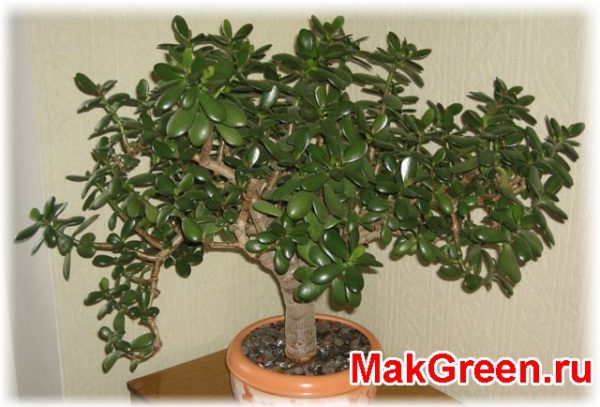
Money tree pests.
This plant is practically not attacked by pests, but if this happens, then most often it is first affected by a variety of bacteria, which gradually kill the fat woman. Then, on a diseased and weakened tree, they can settle in the axils of branches, leaves and other places. root and mealybugs.
- A weak money tree can be attacked by whole colonies of scale insects and false scale insects, get rid of them by rubbing the stems and leaves with a spirit-garlic infusion.
- Crassula can also be attacked by spider mites, gradually wrapping a cobweb around the plant and sucking out all the vital juices from it.
- The money tree root may be affected nematodes, which are not difficult to notice with the naked eye. If you notice such pests, you must immediately remove the affected parts of the plant.
- Also, the tree of happiness can be attacked by aphids, which are recommended to be gotten rid of with special products sold in flower shops.
domznaniy.info/denezhnoe-derevo.html
Use of money tree: medicinal properties and contraindications
 Crassula, otherwise called money tree or crassula, is very popular among gardeners because it does not require care and can, according to many, attract good luck and wealth. In addition, the medicinal properties of the money tree are unique, which most people are simply not aware of. Such properties of this plant with fleshy leaves have long been noticed by traditional healers, who began to use it in the treatment of various diseases.
Crassula, otherwise called money tree or crassula, is very popular among gardeners because it does not require care and can, according to many, attract good luck and wealth. In addition, the medicinal properties of the money tree are unique, which most people are simply not aware of. Such properties of this plant with fleshy leaves have long been noticed by traditional healers, who began to use it in the treatment of various diseases.
The juice of money tree leaves has anti-inflammatory, antiviral and bactericidal properties, which explains the widespread use of the flower in folk medicine. This mini-tree can react to the state of human health and collect all the negative energy. If a person gets sick or experiences severe stress, then the fat plant growing in the room begins to wither and shed its leaves. As soon as the patient begins to feel better, the tree also returns to its original well-groomed appearance.
- Thus, there is a certain energetic connection between the money tree and people - it helps a person to be healthy.
- In addition to these properties, the plant can also be called a filter.
- Due to the substances released, it purifies and disinfects the air, which provides a beneficial effect on people’s well-being and mood.
- Therefore, it is very necessary to grow such a tree on the windowsill in order to use it for medicinal purposes and make the air in the room cleaner. However, it is important to know that Crassula leaves are better suited for external use, which is due to its chemical composition.
Why is it better to use Crassula externally?
Although there are no large-scale studies of the chemical composition of money tree, it is known that it contains arsenic, which can accumulate in the body, leading to negative health effects. And if doctors in ancient times used arsenic-containing drugs to treat certain ailments (fevers, diseases of the nervous system, diseases of the digestive system), then official medicine, due to the toxicity of this element, uses it very limitedly (for example, dentists kill the nerve of a tooth with arsenic).
However, doctors of past years mainly tried to use arsenic to treat various types of skin lesions and external cancers. Modern traditional medicine also considers the use of Crassula leaves from the same perspective - for the treatment of wounds, burns, sprains, bruises.
- It is the presence of arsenic in the money tree that is the main contraindication for its internal use.
- Scientists are engaged in a fierce debate over whether it is possible to use Crassula internally in the treatment of certain diseases, because the risk of using it internally is very high - in case of an overdose, vomiting, diarrhea and impaired consciousness are possible.
- External use of the leaves of this medicinal tree is quite safe.
In what cases can it be used?
Today, Crassula is used to heal many ailments. It is considered very effective when:
- bruises and sprains;
- wounds, cuts, abscesses;
- burns;
- herpes on the lips;
- sore throat, tonsillitis;
- calluses;
- insect bites;
- hemorrhoids;
- ingrown toenail;
- varicose veins;
- arthritis and arthrosis;
- kidney inflammation;
- stomach and duodenal ulcers.

For these diseases, traditional medicine involves the use of Crassula juice, whole or crushed leaves, and infusions made from them. It should be remembered that treatment can not only bring the expected positive effect, but also cause harm to health, which is especially associated with overdose and improper use of the plant.
How to use medicinal leaves and juice from them?
To heal bruises and sprains, you need to squeeze the juice out of the leaves, soak a bandage in it, and then apply it to the damaged area. A film should be applied on top, which can be secured with a bandage. After 3 hours, the bandage must be changed. You can prepare a paste from the leaves and make compresses, which are changed after 4 hours. For a compress, place the prepared gruel on gauze, cover with gauze on top and apply to the sore spot. This remedy is very effective for various wounds, abscesses, burns, sprains, and bruises.
- To get rid of herpes, use juice squeezed from the leaves of the fat plant.
- They need to lubricate the inflamed area on the lip every 30 minutes.
- You can soak a cotton pad in the juice, apply it to the sore and secure it with a band-aid.
- Money tree sap is effective in treating arthritis and relieving inflammation from insect bites.
- You just need to apply the squeezed juice to the affected area - the joints are lubricated overnight, and the swelling from the bite is treated with the juice up to 6 times a day.
- For throat diseases, you can chew 1/3 of a leaf 3 times a day.
- To get rid of stomach and duodenal ulcers, traditional healers recommend eating 2 leaves 1 hour before meals (it is important to chew them thoroughly).
 The leaves of this tree will also help save you from old calluses and ingrown nails. For calluses, you should remove the top film from the leaf and apply it to the callus, securing it securely with a band-aid. This should be done at night until the callus disappears completely. You should also use money tree leaves for ingrown nails - apply a cut leaf to the inflamed area, cover it with a film on top and secure it with a band-aid. The compress should be replaced as the leaf dries, and the nail softened by this procedure is much easier to remove.
The leaves of this tree will also help save you from old calluses and ingrown nails. For calluses, you should remove the top film from the leaf and apply it to the callus, securing it securely with a band-aid. This should be done at night until the callus disappears completely. You should also use money tree leaves for ingrown nails - apply a cut leaf to the inflamed area, cover it with a film on top and secure it with a band-aid. The compress should be replaced as the leaf dries, and the nail softened by this procedure is much easier to remove.
- Juice squeezed from the leaves will also help with hemorrhoids.
- To prepare a healing remedy, you need to squeeze out the juice and add liquid Vaseline to it.
- Soak a cotton swab in the prepared mixture and use it to apply to hemorrhoids.
- The procedure is repeated 2-3 times a day, but first the intestines must be emptied and washed with cold water.
- The applied ointment should be kept for 15-20 minutes.
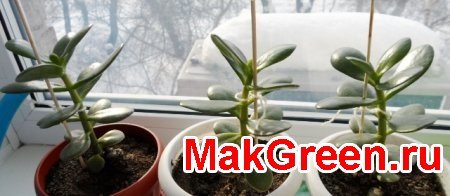 How to use an infusion of leaves?
How to use an infusion of leaves?
To heal the kidneys and eliminate varicose veins, you can prepare a special infusion from the leaves of the medicinal tree. To eliminate inflammatory processes in the kidneys, you need to chop 5 washed leaves, pour them with 1 glass of hot water, leave for 60 minutes. The resulting infusion should be taken before meals (15 minutes) 1 tablespoon 3 times a day.
To get rid of varicose veins, fill a 0.5 liter jar with leaves and branches of the money tree 2/3 full and fill it to the top with vodka.
- Close the jar tightly with a lid and leave for 1 month in a dark place.
- Using the resulting infusion, apply compresses to painful areas.
- The exact same recipe can be used when swelling appears, joints or muscles hurt.
So, this wonderful indoor flower not only decorates the home, but also heals various ailments, giving a person excellent health and a great mood. Therefore, he can safely be called a home doctor who is always ready to help.
narodnymi.com/travnik/denezhnoe-derevo-lechebnye-svojstva-i-protivopokazaniya.htm
Planting a money tree / Crassula (Crassula).
Money tree or Crassula belongs to the genus Crassula. These are the most diverse plants there can be. This genus even contains aquarium plants. Let's consider caring for the popular tree-like Crassula of this genus. Crassula belongs to the succulents. Even a novice gardener who has no experience in growing indoor plants will not have any trouble caring for the plant. How to grow a money tree:
- 1. Pinch off a sprout from a money tree from a rich, successful person.
- 2.Plant the sprout on the growing Moon in a pot of soil, after burying a Chinese coin or a 10-ruble coin in it. 3.When your Money Tree grows, hang a bunch of Chinese coins on it.
- 4.Talk to your money tree every day, praise it for its growth and ask that your income also grow.
- 5. It is best to place your money tree in the abundance sector of your apartment or house - to the southeast. In summer, it is good to take it outside, the plant needs fresh air.
The most suitable temperature in winter is +15 degrees or less, but not lower than +4. Indoors you need to place it on the southeast windows, even Feng Shui recommends it. You need to beware of direct sunlight, as this will cause the leaves to turn red, wither and fall off. The leaves of the “money tree” may fall due to lack of fresh air. You can feed the flower in the summer; twice a month will be enough. Fertilizer for cacti is good. It is not recommended to replant Crassula often. It is necessary to replant a flower only if it has grown greatly or the bush needs to be divided, at least once every 3-4 years. The money tree is planted in the same soil as cacti. Propagated by dividing the bush or cuttings. For cuttings, you need to leave it in the shade for 2-3 days, then put it in water for rooting. Many gardeners claim that this plant can even bloom in indoor conditions.

liveinternet.ru/users/5023641/post374602118
Plant growing calendar
- Like cacti, succulents definitely need a period of rest - from September to February (March) in a cool place, with virtually no watering.
- In summer - warmth and fresh air.
These two points are the key to good growth and well-being of your pet, and for old specimens this way you can provoke a unique flowering.
- Transplantation: in spring.
- Reproduction: in spring and summer.
- Feeding: during the growth period.
 Difficulties in caring for a fat woman
Difficulties in caring for a fat woman
Rather, let’s call it not difficulties, but instructions for the behavior of your money tree. A sudden drop of leaves will tell you in the summer that there was not enough moisture or the water for irrigation was too cold.
- Due to excess moisture, particularly in winter, the leaves may turn pale and wither, but if the plant is not watered enough, they darken and wrinkle, and their shine is lost.
- Damaged ones must be removed.
- I once lost a fat woman because I didn’t take action in a timely manner.
- Signs given by the plant must be responded to immediately.
- Mine had a lot of moisture, but I took it for a lack.
Lack of moisture can also cause brown, dry spots on the leaves. But if the spots are brown but soft, frequent ventilation and treatment with an antifungal agent are recommended. I have never encountered anything like this.
- The base of the stem is rotting - this is most likely root rot, which is difficult to combat.
- Here I can only recommend drastic measures to the readers of MirSovetov (and even then they will help if the roots are alive - not soft and not dark).
- We cut off all the rotten parts, plant them in a clean pot and new soil, or even cut off only the top and begin to grow the tree again.
The long, ugly stem is again due to winter waterlogging and lack of light.
Crassula is practically not affected by pests. If this suddenly happens, then they act according to generally accepted standards for combating a specific pest. But they note that the money tree becomes so close to the one who cares for it that if a person suffers from a psychological or physiological condition, the money tree begins to get sick and may die.
 Growing a tree
Growing a tree
Since the fat plants described above can also have a bush form, in order for it to become a tree, you will have to work hard from the very beginning of growth. The essence of crown formation is to remove the lateral shoots until the tree stretches to the desired height (the bare trunk is about 15 cm, and the plant itself is 25-30 cm), and then we pinch off the top, and the plant, sending out lateral shoots, begins to branch the crown. To prevent the tree from leaning to one side, we periodically turn the pot.
The tree-like form itself grows in the form of a tree - it gradually sheds its lower leaves, exposing the lignified trunk. And only then it begins to bush.
Crassulas, like many succulents, are ideally suited for creating flower arrangements - slides, framing artificial ponds or some kind of indoor flower beds for offices. Plants grow well, are easy to care for and do not require attention for a long time.
mirsovetov.ru/a/housing/plants/money-tree.html


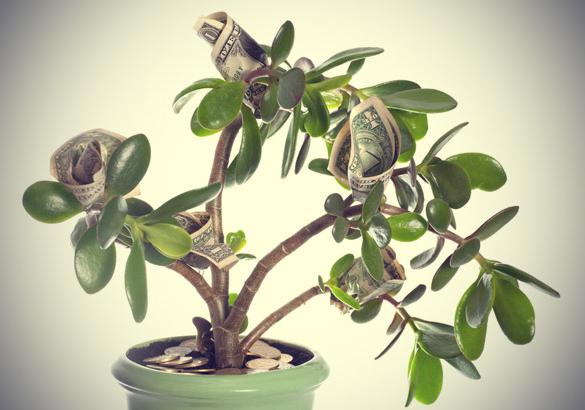
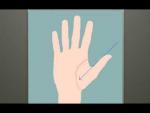

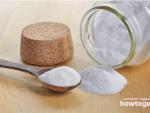



 Nail care
Nail care Prom hairstyle for long hair
Prom hairstyle for long hair 18 wonderful New Year cards that even a child can make
18 wonderful New Year cards that even a child can make The best set of exercises for morning exercises
The best set of exercises for morning exercises